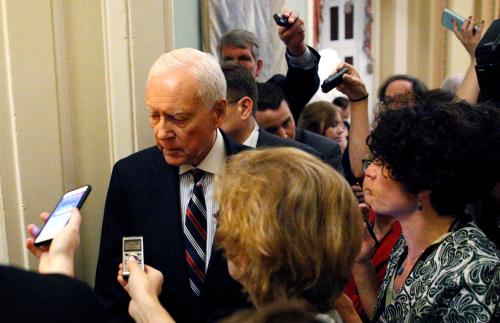This analysis is part of USC-Brookings Schaeffer Initiative on Health Policy, which is a partnership between the Center for Health Policy at Brookings and the University of Southern California Schaeffer Center for Health Policy & Economics. The Initiative aims to inform the national health care debate with rigorous, evidence-based analysis leading to practical recommendations using the collaborative strengths of USC and Brookings.
On June 22, Senate Republicans released their much-awaited health reform bill, the Better Care Reconciliation Act of 2017 (BCRA). Much attention has rightfully focused on the bill’s myriad changes to the Medicaid program and to subsidies for the purchase of private insurance. But the legislation also makes potentially highly impactful changes to state innovation waivers, which are included in section 1332 of the Affordable Care Act (ACA).
Under current law, section 1332 provides broad flexibility for states to waive key ACA provisions so long as health coverage is not jeopardized and federal deficits not increased. Waivers can affect a wide range of provisions, including the premium tax credit, the definition of essential health benefits, the requirement that insurance plans cap annual out-of-pocket spending, and the requirement for states to operate a Marketplace, among others.
The changes in the Senate bill would upset this structure, removing the coverage-related guardrails and thereby opening the door for states to pursue waivers that would result in substantial losses in health coverage and affordability. The weakened guardrails would also allow states significant latitude to misuse federal health care dollars.
SECTION 1332 UNDER CURRENT LAW
Section 1332 permits states to apply for a waiver to eliminate or modify many of the ACA’s central coverage provisions. If a waiver results in a reduction of federal subsidies flowing to the state, the state can receive the difference in “pass-through funding” to implement the state’s own plan for providing coverage. Waivers are approved jointly by the Secretary of Health and Human Services and the Treasury (collectively, the Secretaries).
The statute clearly defines which provisions may be waived. These include:
- The premium tax credit and cost-sharing reductions
- The individual and employer mandates
- The health insurance marketplaces and rules regarding what plans can be offered there
- Certain additional rules governing health insurance coverage, including the definition of essential health benefits, the requirement that insurance plans cap annual out-of-pocket spending, and the rules regarding actuarial value.
Before the Secretaries can approve a waiver, they must determine that it satisfies certain requirements or “guardrails” related to coverage and deficit neutrality.
- A waiver may not reduce the number of people with health coverage
- A waiver may not reduce the affordability of health coverage
- A waiver may not reduce the comprehensiveness of health coverage.
- A waiver may not increase the federal deficit.
Even if these guardrails are satisfied, the Secretaries retain discretion to approve or deny a waiver based on other considerations.
Before a state can apply for a waiver, it must pass legislation enacting the state’s plan to provide coverage under the waiver. A waiver is limited to five years, with the possibility of renewal.
Senate Bill Changes to Section 1332
While the Senate bill does not modify the list of provisions that states can waive under Section 1332, the Senate bill does make two major changes to the requirements for securing a waiver that greatly increase their potential reach:
It eliminates the requirement that a waiver not adversely impact health coverage.
The Senate bill would eliminate the three guardrails related to insurance coverage, leaving only the requirement that a waiver not increase the federal deficit. (The bill would also tweak the language of the deficit neutrality rule, but it is not clear what impact that change would have.)
The Senate bill does add a requirement that the application include a “description” of “alternative means” for “increasing access to comprehensive coverage, reducing average premiums, and increasing enrollment.” However, the legislation is clear that these factors would not be considered for purposes of waiver approval. Waiver approval would be based on deficit neutrality alone.
It eliminates the Secretaries’ discretion to reject a waiver for other reasons.
Currently section 1332 provides that the Secretaries “may” approve a waiver that satisfies the four statutory requirements. The Senate bill amends this to provide that they “shall” approve the waiver unless it would increase deficits.
The Senate bill would also make several additional changes that could magnify the effects of these two major changes:
It forbids waiver revocation, even if it ends up increasing deficits or causing other problems.
Currently section 1332 does not address the possibility of revoking a waiver once granted. Relying on their general rule-making authority and existing precedents, the Departments promulgated regulations defining the conditions for revoking a waiver. The Senate bill would override these regulations, providing that a state innovation waiver “may not be cancelled by the Secretary before the expiration of the 8-year period (including any renewal period…).’’
It extends the maximum waiver period to 8 years.
Current law limits a waiver to 5 years.
It permits states to apply for a waiver without enacting authorizing legislation.
The Senate bill eliminates the requirement that a state enact authorizing legislation. While legislation remains an option, the bill would also allow a state’s governor and insurance commissioner to provide a “certification” providing “authority for State actions under a waiver…”
The waiver would also create a $2 billion fund to incentivize states to apply for waivers.
Key Concerns Raised by the Section 1332 Provisions of Senate Bill
The changes the Senate bill would make to Section 1332 raise several major concerns.
The bill allows changes that would increase the number of people uninsured and make health coverage less affordable and less comprehensive.
Section 1332 currently strikes a delicate balance between allowing state flexibility and preserving the key coverage goals of the ACA. The Senate bill would disrupt this balance by removing requirements that a waiver preserve insurance coverage, affordability, and comprehensiveness. The bill also eliminates the Secretary’s discretion to reject a waiver on other policy grounds, further weakening protection against waivers with adverse policy effects. As a result, a waiver that simply avoids increasing the deficit would automatically be approved, even if it would increase the ranks of the uninsured or reduce the affordability or comprehensiveness of coverage.
The bill allows states to waive essential health benefits and limits on enrollees’ out-of-pocket costs, harming individuals with high health costs or needs for services no longer covered in the state and nationwide.
Under current law, EHBs are formally waivable, as they are contained in ACA section 1302, which is among the provisions enumerated in section 1332. But the comprehensiveness guardrail effectively prevents EHBs from being waived by requiring coverage under the waiver to be just as comprehensive as absent the waiver. Indeed, the comprehensiveness guardrail specifically identifies EHBs as the standard of comprehensiveness. The Senate bill eliminates that guardrail, allowing EHBs to be waived either partially or in full.
Allowing states to waive or roll back EHBs raises two key concerns:
- Issuers would have a strong incentive to offer plans that do not cover services needed by individuals with pre-existing conditions or other expensive needs, as they did before the ACA. Many plans may stop covering services such as cancer care, prescription drugs, maternity services, and substance abuse and mental health treatments. Alternatively, plans may offer some of these services, but limit how much they will pay out in a given year. Because community rating (the requirement that plans offer the same premiums to everyone regardless of health status) would remain in effect, plans seeking to attract healthier individuals to avoid a death spiral would need to limit services that attract sicker enrollees. As a result, it is likely that no one in a state’s individual market that waived EHBs would have access to comprehensive coverage. Insurers would likely sell separate policies for benefits not covered in their core plan offerings, but these supplemental policies would be subject to tremendous adverse selection, leading to very high premiums and enrollment almost exclusively by those with pre-existing conditions. The result would be a return to world where individuals with pre-existing conditions pay far more for the coverage they need, or are unable to afford adequate coverage at all.
- Individuals in these states’ individual and small group markets, as well as people who work for large employers nationwide, could see lifetime and annual limits imposed on their benefits and lose protection against high annual out-of-pocket spending. The reason, as my colleague Matt Fiedler explains, is that these limits are prohibited only with respect to the care that is included in EHBs, and each employer can choose any state’s EHB definition.
As a result, it is likely that no one in a state’s individual market that waived Essential Health Benefits would have access to comprehensive coverage.
The Senate bill creates a similar dynamic with respect to the requirements that health plans limit enrollees’ exposure to health costs and provide a minimum level of generosity. Under current law, once an enrollee’s out-of-pocket spending reaches an annual maximum (for example, $14,300 for a family in 2017), the insurance company picks up the rest of the cost without additional cost-sharing. And no plan in the individual or small group market may have an actuarial value (AV)—a measure of plan generosity—below 60 percent (58 percent based on guidance allowing de minimis variation). Like EHBs, out-of-pocket limits and the AV requirement appear in section 1302 of the ACA, which is explicitly designated to be waivable under Section 1332. However, the affordability guardrail currently prevents states from significantly undermining these protections. By eliminating that guardrail, the Senate bill would allow states to eliminate them.
The bill allows states to misuse federal health care dollars.
By vastly loosening the requirements for waiver approval and limiting federal oversight, the Senate bill opens the door to abuse of federal health care dollars.
Eliminating the coverage-related guardrails means that a waiver could provide the state with federal pass-through dollars without meaningfully supporting health care coverage. And eliminating Secretarial discretion to deny a waiver exacerbates this problem. For example, a state could waive the premium tax credit and repurpose those funds to an ineffective and wasteful health care program. Or a state could enact cuts to state public health programs and then apply for a waiver that used federal subsidy dollars to pay for those programs – effectively syphoning off federal dollars into the state budget. A state could even use pass-through funding for non-health purpose like housing or tax cuts, so long as the application included some justification – however far-fetched – for how the program contributed to coverage and affordability. In all of these cases, the federal government would not just be permitted to approve the waiver; it would have no choice but to approve the waiver.
This concern is compounded by removing the requirement for state legislation authorizing a waiver. Permitting the state executive branch acting alone to seek a waiver increases the risk of ill-conceived and unscrupulous waivers. These concerns are further compounded by the provision preventing the federal government from revoking a waiver for it full life, generally eight years. As a result, even a waiver that turned out to increase deficits could not be revoked.
Conclusion
There are cogent reasons for increasing state flexibility to achieve national objectives in creative ways that are responsive to particular state circumstance. But there is no case for loosening waiver authority so much that states can use federal taxpayers’ money to subvert the goals of health reform.
Jason A. Levitis is a Senior Fellow at the Yale Law School’s Solomon Center for Health Law and Policy. Until January of 2017, he led ACA implementation at the U.S. Treasury Department. In that capacity, he co-chaired an interagency work group charged with implementing the state innovation waiver program.
The authors did not receive financial support from any firm or person for this article or from any firm or person with a financial or political interest in this article. They are currently not an officer, director, or board member of any organization with an interest in this article.






Commentary
Changes to state innovation waivers in the Senate health bill undermine coverage and open the door to misuse of federal funds
June 23, 2017